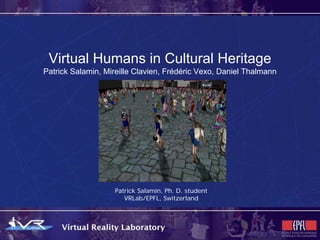Virtual Humans in Cultural Heritage
- 1. Virtual Humans in Cultural Heritage Patrick Salamin, Mireille Clavien, Fr├®d├®ric Vexo, Daniel Thalmann Patrick Salamin, Ph. D. student VRLab/EPFL, Switzerland
- 2. 2 Outline ŌĆó Introduction ŌĆó The avatars in Cultural Heritage ŌĆō Creation of an avatar ŌĆō Crowds: requirements and constraints ŌĆō Avatars behavior ŌĆō Navigation graphs ŌĆō Creation of a smart environment ŌĆó Conclusion
- 3. 3 Introduction ŌĆó Motivation: ŌĆó Adding believable characters to virtual reconstructions allows non-experts a better emotional involvement in a virtual reality scene. ŌĆó Examples based on european projects: Erato, Cahrisma, Epoch, Pompeii
- 4. 4 Contributions ŌĆó Adding variety ŌĆō Texture and animation ŌĆó Providing tools for crowd setting up ŌĆō Brushes ŌĆó Automatic navigation graphs ŌĆó Interaction with semantic environments
- 5. 5 Avatar creation ŌĆó 3DS Max exporting ŌĆō Pipe-line for converting character and animation data to format usable by crowd rendering and animation engine ŌĆō Exported data: ŌĆó Mesh ŌĆó Texture ŌĆó UV coordinates ŌĆó Skeleton hierarchy ŌĆó Deformations bindings ŌĆó Animations
- 6. 6 Avatar creation ŌĆó Textures design - Optimize texture mapping: only one material for each mesh - => all visual elements (clothes, skin, face) are mixed in one single texture ŌĆō Reduce texture size max 512x512 pixels
- 7. 7 Avatar creation ŌĆó Deformations design ŌĆō Adapt skeleton and deformation boxes to each mesh ŌĆō Adjust deformations parameters ŌĆō Key-postures to test deformations
- 8. 8 Avatar variety 1 ŌĆó Textures design ŌĆō Use same texture mapping for different meshes ŌĆō Generate many different characters by varying colours 7 templates and 15 textures create an infinite variety of virtual romans
- 9. 9 Avatar variety 2 ŌĆó Each template has various sets of animation corresponding to specific emotional states
- 10. 10 Avatar variety 3 ŌĆó Variety of walking animations is ensured in realtime by slight rotation shifting on spine and arms joints Roman social classes are differentiated through clothes colors and walking style (spine bending)
- 11. 11 Crowd: requirements & constraints ŌĆó Technical challenges: increased demand on computational resources ŌĆō Multi-agent: large number of agents ŌĆō Collision avoidance ŌĆō Agent-agent interactions ŌĆō Interaction with environment ŌĆō Interaction with users ŌĆō Different from single agent simulations ŌĆō Conceptual differences: need for variety
- 12. 12 Behavior ŌĆó Virtual human agent ŌĆō 3D graphic body representation ŌĆō able to perform low-level actions (walking with different gaits, playing animations of gestures, postures, speak, etc.) ŌĆō Has set of internal attributes corresponding to various psychological, physical or scenario states (mobility, role, body size, etc.)
- 13. 13 Behavior ŌĆó Virtual human agent ŌĆō Has set of higher level complex behaviors (wander, follow-path, script, etc.) ŌĆō Has set of rules determining selection of these behaviors ŌĆō Able to receive events from: ŌĆó Environment ŌĆó Other agents ŌĆó User interface
- 14. 14 Behavior ŌĆō spray paradigm ŌĆó Brushes ŌĆō Tools with visual representation on the screen ŌĆō Affect crowd members in different manners: ŌĆó Create new individuals in the scene ŌĆó Change their appearances or behaviors Negative Plebeians Patricians Neutral Deletion brush Creation brush Nobles Positive
- 15. 15 Behavior ŌĆō manual and automatic
- 16. 16 Walking ŌĆō procedural modeling ŌĆó Virtual Cultural Heritage ŌĆō Main focus on reconstruction of major monuments ŌĆō But: complete site models are needed for authentic simulations. ŌĆó Provide environment models at moderate cost. ŌĆó Procedural models contain semantic information inherently (e.g. construction history) ŌĆó Credits: ŌĆō S. Haegler, P. Mueller, and Prof. L.v.Gool at Computer Vision Lab, ETH Zurich M├╝ller, Vereenooghe, Vergauwen, Van Gool, Waelkens The Antonine Nymphaeum at Sagalassos, 2004
- 17. 17 Walking ŌĆō navigation graph ŌĆó Vertices = walkable space ŌĆó Edges = Gates ŌĆó Navigation Flow = Set of Paths ŌĆó [Pettr├® et al. 06,07]
- 18. 18 Walking ŌĆō navigation graph ŌĆó Rendered geometry
- 19. 19 Walking ŌĆō navigation graph ŌĆó Geometry semantics
- 20. 20 Walking ŌĆō roman crowd behavior
- 23. 23 Walking ŌĆō bakeries/shops result
- 24. 24 Walking ŌĆō look at
- 25. 25 Walking ŌĆō stop look at
- 26. 26 Walking ŌĆō look at results
- 27. 27 Walking ŌĆō final navigation graph ŌĆó Navigation graphs automatically generated depending on the environment geometry [Pettr├® et al. 06,07]
- 29. 29 Smart environment ŌĆó Virtual character reacts differently depending on the environment ŌĆó Smart object: both avatar and object interact in the animation
- 30. 30 Thanks for your attention!

















![17
Walking ŌĆō navigation graph
ŌĆó Vertices = walkable space
ŌĆó Edges = Gates
ŌĆó Navigation Flow = Set of Paths
ŌĆó [Pettr├® et al. 06,07]](https://image.slidesharecdn.com/05vsmm09workshopsalamin-091026114702-phpapp01/85/Virtual-Humans-in-Cultural-Heritage-17-320.jpg)









![27
Walking ŌĆō final navigation graph
ŌĆó Navigation graphs automatically generated
depending on the environment geometry [Pettr├® et
al. 06,07]](https://image.slidesharecdn.com/05vsmm09workshopsalamin-091026114702-phpapp01/85/Virtual-Humans-in-Cultural-Heritage-27-320.jpg)


